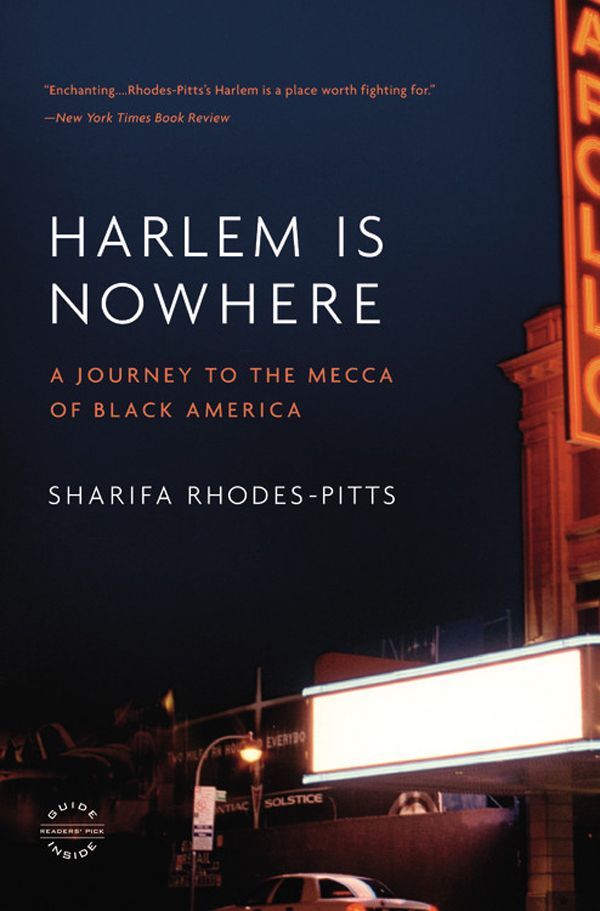
Harlem Is Nowhere
A Journey to the Mecca of Black America
کتاب های مرتبط
- اطلاعات
- نقد و بررسی
- دیدگاه کاربران
نقد و بررسی

Starred review from November 1, 2010
Rhodes-Pitts, an essayist and recipient of the Rona Jaffe Foundation Writer's Award, takes as her title a 1948 essay wherein Ralph Ellison describes "nowhere" as the crossroads where personal reality meets the metaphorical meanings attached to people and places. A transplant to Harlem from Texas, Rhodes-Pitts began a personal journey into the iconic neighborhood, poring over Harlem in literature and life, reading its empty lots and street scenes, its billboards and memorials for clues to what it means to inhabit a dream (that fabled sanctuary for Black Americans) and a real place (the all too material neighborhood buckling beneath relentless gentrification). Acutely conscious of the writer's simultaneous role of participant in and recorder of present and past, Rhodes-Pitts weaves a glittering living tapestry of snatches of overheard conversation, sidewalk chalk scribbles, want ads, unspoken social codes, literary analysis, studies of black slang—all if it held together with assurance and erudition. Like Zora Neale Hurston (whose contradictions she nails), she is "tour-guide and interpreter" of a Mecca cherished and feared, a place enduring and threatened that becomes home.

October 15, 2010
One woman's quest to discover the heart of Harlem.
In her debut, Rhodes-Pitts alternates between the personal and the scholarly in an attempt to define the importance of the place, both for African-Americans and the country at large. It is a complicated tale with a "loathsome history of neglect and destruction stretching back to the beginning of black settlement in Harlem and its corollary, white flight." Yet Harlem is more than a neighborhood with racial roots, which the author proves by focusing primarily on its cultural contributions. Rhodes-Pitts relies heavily on Harlem's famed writers to tell its history, yet the words of Langston Hughes, Ralph Ellison, James Baldwin, Toni Morrison and Nella Larsen do little more than create a shoddy patchwork of familiar terrain. The author also explores Harlem through visuals—descriptions of statues, advertisements, signage, even funeral portraiture—yet photographs are her staple, particularly the work of James VanDerZee, whose photos depict "provided an antidote to the destitute, shell-shocked image then attached to the neighborhood, forming a new iconography of its best days." For Rhodes-Pitts, these photos served as portals to an earlier time, escorting "the viewer halfway into the interior life of Harlem." Unfortunately, readers may never feel connected to the other half. The author's most successful attempts at a complete view of Harlem are the personal stories from the people themselves, yet even this strategy is employed with varying success. The book's primary shortfall is the author's genre-indecisiveness. Part memoir, part scholarly prose, the result is a peculiar hybrid incapable of fully capitalizing on the merits of either genre. Further, the author's overreliance on quotations leaves little room for her own insights and expertise on the subject.
A highly informative though rarely analytical take on one of America's most thriving cultural communities. See Jonathan Gill's upcoming Harlem (2011) for more comprehensive coverage.
(COPYRIGHT (2010) KIRKUS REVIEWS/NIELSEN BUSINESS MEDIA, INC. ALL RIGHTS RESERVED.)

November 1, 2010
The author reflects on her own Harlem, as well as the Harlem of its iconic storytellers.
Copyright 2010 Library Journal, LLC Used with permission.

December 15, 2010
Harlem is firmly enshrined at the very center of African American culture and has been much celebrated and chronicled since the growing numbers of blacks coming to New York were met with housing discrimination that forced them into the neighborhood in the late 1800s. Rhodes-Pitts compares and contrasts her own experience of moving from Texas to Harlem with accounts from literature of the Harlem Renaissance and other cultural glories and news reports of gentrification. She recalls characters from Alain Locke, Langston Hughes, Zora Neale Hurston, Ralph Ellison, and other writers who struggled to find a place for themselves in Harlem even as she listens in on tour-guide lectures and reads contemporary accounts of the changing real-estate and cultural landscape of Harlem that signify a very different future than the one imagined by the fiction writers. Settling into her own place in Harlem, she offers vivid portraits of the residents, who straddle the past and present of the storied neighborhood, many wondering themselves about their futures and the future of Harlem.(Reprinted with permission of Booklist, copyright 2010, American Library Association.)

























دیدگاه کاربران